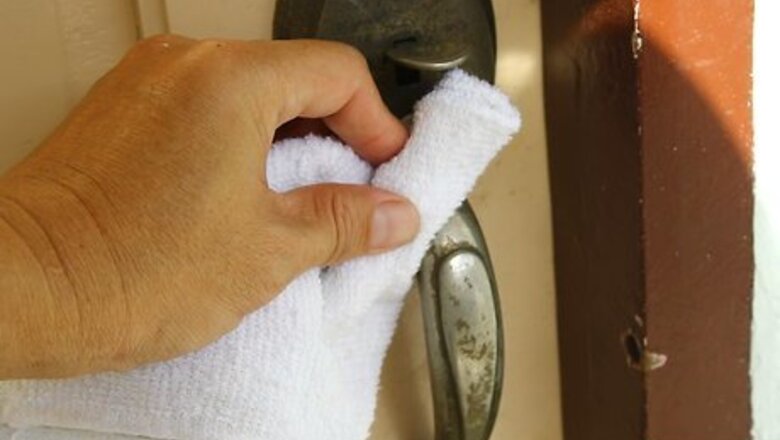
views
Polishing Lacquered Brass
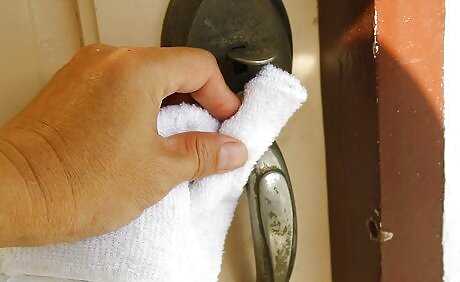
Wipe the brass with a soft, damp cloth. Run a soft rag under lukewarm water. Wring out the excess, then wipe the brass with the damp cloth using small circular motions. Lacquer is a protective coating, and for lacquered pieces, most mild to moderate dullness can be buffed out with physical means rather than chemical ones. In fact, if you use a household cleaner or other type of polish, you risk ruining the lacquer coating. Use a soft cotton or terrycloth rag for best results.
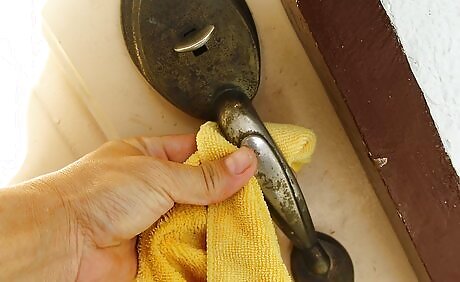
Buff gently with a dry cloth. If the lacquered brass still appears somewhat dull, take a dry cloth and buff the surface for several minutes, working across the entire surface in small, circular motions. For this part of the process, you could consider using either cotton cloth or jewellers' cloth. Jewellers' cloth has an outer layer of soft flannelet and an inner layer of flannel with bits of hematite embedded into it. This hematite acts as a fine abrasive. Note that if you do use jewellers' cloth, you should buff with the abrasive side first and follow up by buffing with the non-abrasive side to remove and residue left behind by the hematite.
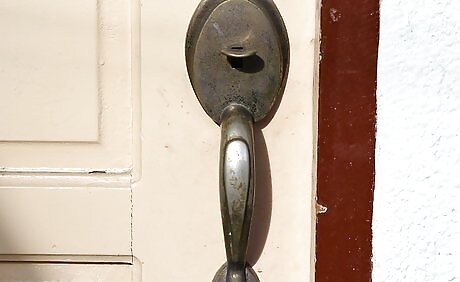
Assess the brass. At this point, the brass should appear fairly polished. If it still looks tarnished and dull, however, you may need to strip the lacquer completely and clean the brass more thoroughly.
Using Commercial Brass Polish

Choose the right polish. Many commercial metal polishes can be too abrasive for some brass items. As a general rule, look for a polish specifically labeled to work for brass. One labeled for use on the particular brass item you intend to polish is an even better choice. Use a wadding-type polish when possible. Other types of commercial polish can be too rough since they are formulated to clean automotive metals or stainless steel. Avoid products that contain tarnish inhibitors since they tend to leave a film on the surface of the brass. Also avoid products containing ammonia since ammonia can dissolve the copper component of brass. Common brands include Brasso, Bar Keepers Friend, Never Dull, Cameo, Hagerty and Blitz.
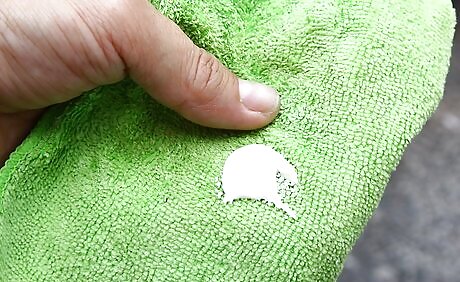
Apply the polish to a dry cloth. Squeeze a dollop of the brass polish onto a soft cloth. A little can go a long way, so you do not need to use much. Use a soft cotton or terrycloth rag for best results. It is recommended that you apply the polish to the cloth instead of applying it directly to the surface of the brass. Applying the polish to the brass can make it more difficult to spread the polish evenly, and as a result, one portion of the brass might get a higher concentration of polish than the rest of the surface.
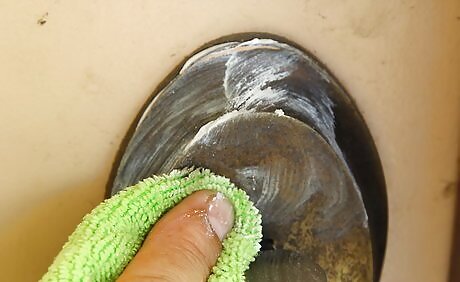
Buff the brass. Wipe the brass down with the polish-coated cloth, applying even pressure in small, circular motions. Cover the entire surface in this manner. Follow the label instructions on the polish when applying it, even if they differ from those described here. Most polishes work in the same way, but different formulas can have slightly different requirements, and using a polish improperly can result in damage to your brass.
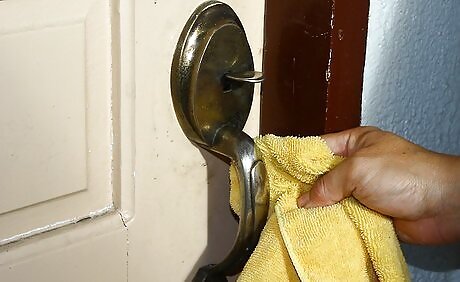
Rinse and dry to remove residual polish. For some polishes, you may need to wipe the polish off with a damp cloth before buffing gently with a clean, dry cloth. Some polishes do not need to be rinsed off. Even for these polishes, though, you should still buff the surface with a dry cloth.
Vinegar and Flour Polish
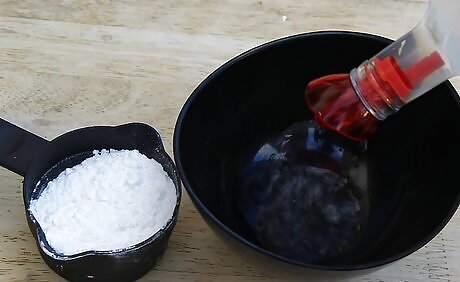
Combine distilled white vinegar and flour. Mix 2/3 cup (160 ml) of distilled white vinegar with 2/3 cup (160 ml) flour. Stir the ingredients together in a plastic or glass bowl until smooth and thoroughly combined. Never use a metal dish to combine the ingredients. If possible, you should also use a plastic or wooden utensil to mix the ingredients over a metal one. Vinegar is acidic, and this acidic quality can dissolve debris responsible for tarnishing and dulling brass. The flour makes the polish slightly more abrasive, but the main benefit of flour is that it thickens the vinegar and creates a paste.
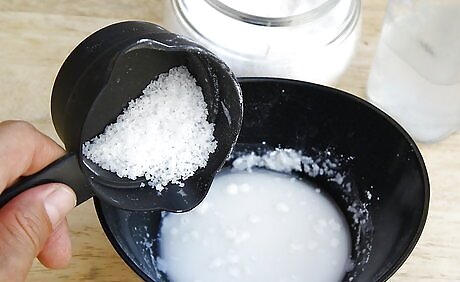
Add a little salt. Mix 1/2 cup (125 ml) salt into the paste until well combined. The salt adds an abrasive component to the paste. It works, both chemically and physically, to make the paste more effective. Note that this paste will not store well, so you should only make as much as you need at the present moment.
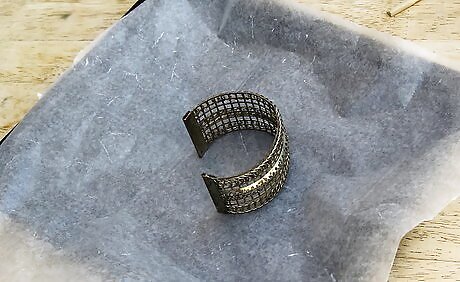
Arrange your brass items on a platter. You'll need to let the polish paste sit on the brass for a prolonged period of time, so you should arrange the brass items in need of polishing on a plastic or glass platter and in a single layer. If you decide to use a metal baking sheet, line it with a layer of parchment paper or wax paper first to avoid letting the brass and the paste come into direct contact with the metal sheet.
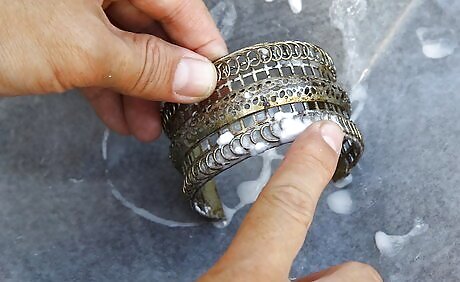
Apply the paste and let it sit. Use a spoon or your fingers to apply the paste in a thick, even coat onto all sides of the brass surface. Allow the paste to sit on the brass for at least 1 to 2 hours, if not longer. For severely tarnished or dulled brass, you can even leave the paste on overnight. As the vinegar paste does its thing, you should see it take on a green tint. This green tint is a natural result produced by the chemical action taking place, and it means that the tarnish and surface debris being dissolved and removed.

Wash off the dried paste. When the brass is ready, gently scrub the paste off with a soft cloth and lukewarm running water. Gently buff the surface of the brass using small circular motions as you rinse. Use a soft cotton or terrycloth rag for best results. Scrub the surface of the brass thoroughly to make sure that all the paste has been removed. Depending on how thick your paste ended up being, it could take a bit of scraping with your thumbnail to chip it away.

Buff with a dry cloth. To dry the brass and give it a final boost of shine, buff it with a soft, dry cloth using small circular passes until you cover the entire surface.
Ketchup Polish

Squirt a dollop of ketchup onto a soft cloth. A lot can go a long way, so you only need about 1 to 2 tsp (5 to10 ml) of ketchup, at most. Use a soft cotton or terrycloth rag for best results. Tomato juice is a mild acid, so the use of tomato-based products can help dissolve debris causing tarnish and dullness on your brass. Ketchup is your best option since it is so thick, but in the absence of ketchup, you could also try tomato paste or tomato juice.
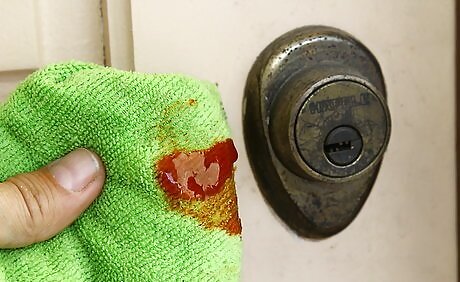
Rub the surface of the brass with the ketchup. Wipe the sides of the brass object down with the ketchup-covered cloth, coating all sides in the ketchup. For best results, rub the ketchup on in a single direction instead of rubbing it on in a back-and-forth motion or a circular motion.
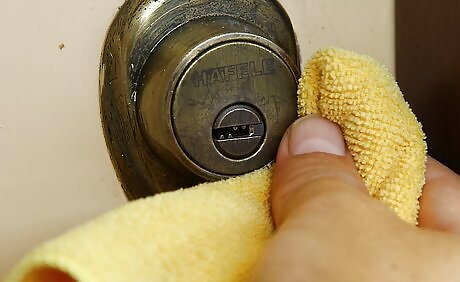
Wipe off the residue. Use a damp cloth to wipe off the ketchup after allowing the tomato substance to sit on the surface for a couple of minutes. You could also rinse the brass under running water to get the ketchup off, but using a damp cloth provides the added benefit of a little extra buffing.
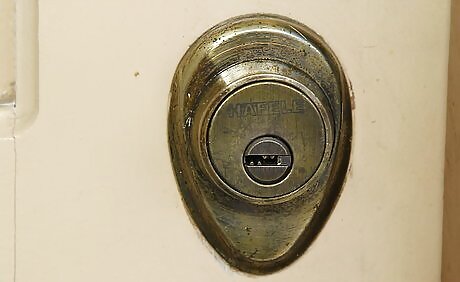
Buff until dry and shiny. Use a dry, soft cloth to dry off any remaining moisture while giving the brass a final shine. Thoroughly buff the entire surface by passing over it in small, circular motions.
Lemon Juice Polishes
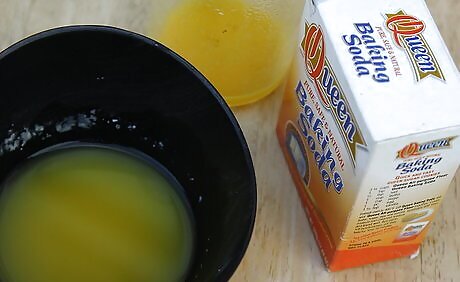
Combine acidic lemon juice with a mild abrasive. The most common abrasives including baking soda and cream of tartar. Alternatively, you could also use half of a lemon and a little salt. Combine 1 to 2 Tbsp (15 to 30 ml) of lemon juice with 1 to 2 tsp (5 to 10 ml) of baking soda. The mixture should fizz at first, but gradually calm down once you stir it together. Mix 1 Tbsp (15 ml) lemon juice with 2 Tbsp (30 ml) cream of tartar, combining the two together to form an evenly thick paste. If using lemon and salt, cut a lemon in half and remove the seeds from one half. Coat the cut surface with table salt until well-coated.
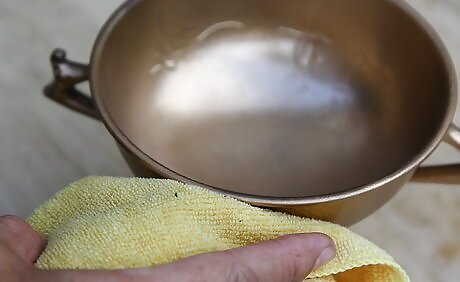
Apply the lemon juice to the brass. Use a soft cloth or your fingers to wipe the lemon paste onto the surface of the brass, coating it completely. Rub the paste on in a single direction for best results. Use a soft cotton or terrycloth rag for best results. A lemon-and-baking-soda paste only needs to sit for a few minutes, but a lemon-and-cream-of-tartar paste should sit on the brass for about 30 minutes. If going the lemon-and-salt route, rub the salt-covered lemon half over the entire surface of the brass. Apply more salt to the lemon as needed until the entire brass surface has been polished.
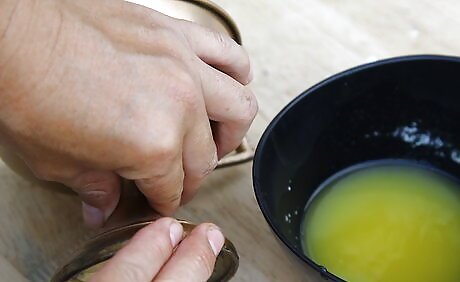
Rinse off the residue. Place the brass under lukewarm running water and gently wipe the residue away with your fingers. If parts of the brass still seem dull, you can reapply the lemon solution of choice to that area for additional shine.
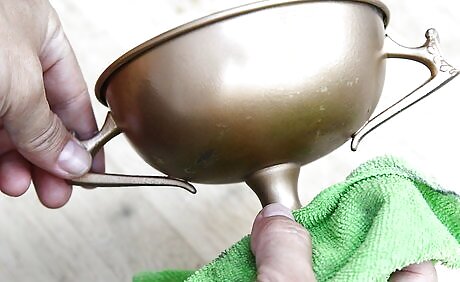
Dry and buff with a soft cloth. Wipe the brass dry with a soft, clean towel. Apply even pressure in small, circular passes to give the brass an extra buffing.
















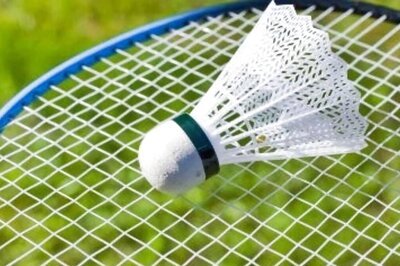

Comments
0 comment